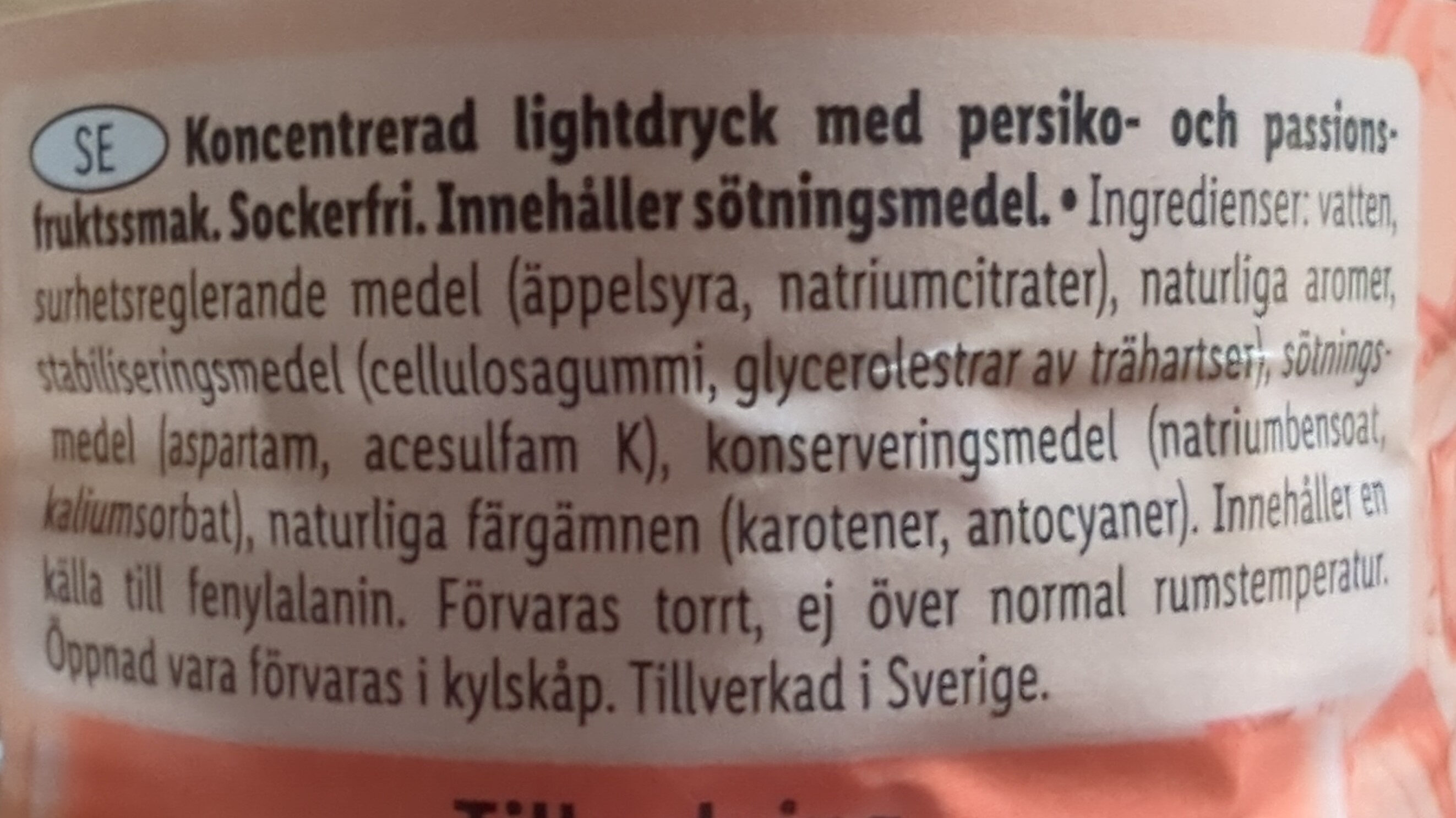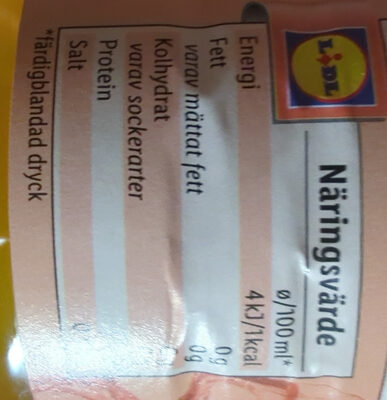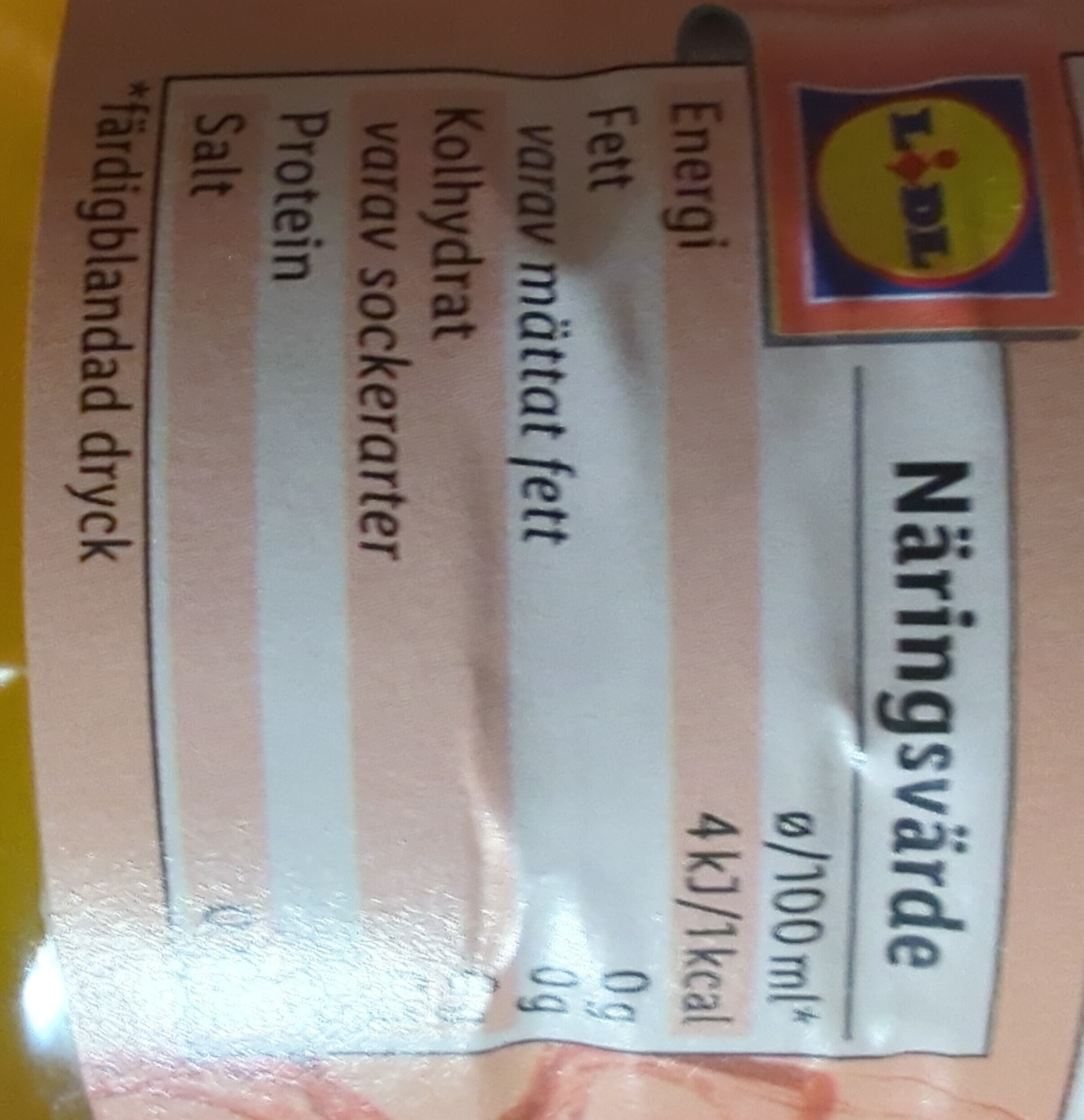Help us make food transparency the norm!
As a non-profit organization, we depend on your donations to continue informing consumers around the world about what they eat.
The food revolution starts with you!
LIGHT persika passion - Solevita - 1L
LIGHT persika passion - Solevita - 1L
This product page is not complete. You can help to complete it by editing it and adding more data from the photos we have, or by taking more photos using the app for Android or iPhone/iPad. Thank you!
×
Streckkod: 4056489266204 (EAN / EAN-13)
Kvantitet: 1L
Förpackning: Plast
Varumärken: Solevita
Kategorier: Växtbaserad mat och dryck, Drycker, Växtbaserade drycker, Fruktbaserade drycker, en:Juices and nectars, Fruktsafter, en:Fruit juices from concentrate, en:Peach juices, Persikosjuice från koncentrat
Etiketter, certifieringar, utmärkelser: Innehåller en fenylalaninkälla
Ingredients ursprung: Sverige
Tillverknings eller bearbetningsplats: Sweden
Butiker: Lidl
Länder där såld: Sverige
Matching with your preferences
Hälsa
Ingredienser
-
18 ingredienser
Vatten, surhetsreglerande medel (äppelsyra, natriumcitrater), naturliga aromer, stabiliseringsmedel (cellulosagummi, glycerolestrar av trähartser, sötnings - medel (aspartam, acesulfam K), konserveringsmedel (natriumbensoat, kaliumsorbat), naturliga färgämnen (karotener, antocyaner). Innehåller en källa till fenylalanin.
Food processing
-
Ultra processed foods
Elements that indicate the product is in the 4 - Ultra bearbetade livsmedel och drycker group:
- Tillsats: E163 - Antocyaner
- Tillsats: E445 - Glycerolestrar av trähartser
- Tillsats: E466 - Karboximetylcellulosa
- Tillsats: E950 - Acesulfam k
- Tillsats: E951 - Aspartam
- Ingrediens: Arom
Food products are classified into 4 groups according to their degree of processing:
- Obearbetade eller minimalt bearbetade livsmedel
- Bearbetade kulinariska ingredienser
- Halvfabrikat
- Ultra processed foods
The determination of the group is based on the category of the product and on the ingredients it contains.
Tillsatser
-
E163 - Antocyaner
Anthocyanin: Anthocyanins -also anthocyans; from Greek: ἄνθος -anthos- "flower" and κυάνεος/κυανοῦς kyaneos/kyanous "dark blue"- are water-soluble vacuolar pigments that, depending on their pH, may appear red, purple, or blue. Food plants rich in anthocyanins include the blueberry, raspberry, black rice, and black soybean, among many others that are red, blue, purple, or black. Some of the colors of autumn leaves are derived from anthocyanins.Anthocyanins belong to a parent class of molecules called flavonoids synthesized via the phenylpropanoid pathway. They occur in all tissues of higher plants, including leaves, stems, roots, flowers, and fruits. Anthocyanins are derived from anthocyanidins by adding sugars. They are odorless and moderately astringent. Although approved to color foods and beverages in the European Union, anthocyanins are not approved for use as a food additive because they have not been verified as safe when used as food or supplement ingredients. There is no conclusive evidence anthocyanins have any effect on human biology or diseases.Källa: Wikipedia (Engelska)
-
E202 - Kaliumsorbat
Potassium sorbate: Potassium sorbate is the potassium salt of sorbic acid, chemical formula CH3CH=CH−CH=CH−CO2K. It is a white salt that is very soluble in water -58.2% at 20 °C-. It is primarily used as a food preservative -E number 202-. Potassium sorbate is effective in a variety of applications including food, wine, and personal-care products. While sorbic acid is naturally occurring in some berries, virtually all of the world's production of sorbic acid, from which potassium sorbate is derived, is manufactured synthetically.Källa: Wikipedia (Engelska)
-
E211 - Natriumbensoat
Sodium benzoate: Sodium benzoate is a substance which has the chemical formula NaC7H5O2. It is a widely used food preservative, with an E number of E211. It is the sodium salt of benzoic acid and exists in this form when dissolved in water. It can be produced by reacting sodium hydroxide with benzoic acid.Källa: Wikipedia (Engelska)
-
E296 - Äppelsyra
Malic acid: Malic acid is an organic compound with the molecular formula C4H6O5. It is a dicarboxylic acid that is made by all living organisms, contributes to the pleasantly sour taste of fruits, and is used as a food additive. Malic acid has two stereoisomeric forms -L- and D-enantiomers-, though only the L-isomer exists naturally. The salts and esters of malic acid are known as malates. The malate anion is an intermediate in the citric acid cycle.Källa: Wikipedia (Engelska)
-
E331 - Natriumcitrater
Sodium citrate: Sodium citrate may refer to any of the sodium salts of citrate -though most commonly the third-: Monosodium citrate Disodium citrate Trisodium citrateThe three forms of the salt are collectively known by the E number E331. Sodium citrates are used as acidity regulators in food and drinks, and also as emulsifiers for oils. They enable cheeses to melt without becoming greasy.Källa: Wikipedia (Engelska)
-
E445 - Glycerolestrar av trähartser
Glycerol ester of wood rosin: Glycerol ester of wood rosin, also known as glyceryl abietate or ester gum, is an oil-soluble food additive -E number E445-. The food-grade material is used in foods, beverages, and cosmetics to keep oils in suspension in water, and its name may be shortened in the ingredient list as glycerol ester of rosin. It is also used as an ingredient in the production of chewing-gum and ice cream. Similar, less pure materials -glycerol ester of gum rosin- are used as a component of certain low-cost adhesives.To make the glycerol ester of wood rosin, refined wood rosin is reacted with glycerin to produce the glycerol ester. Glycerol ester of wood rosin is an alternative to brominated vegetable oil in citrus oil-flavored soft drinks. In some cases, both ingredients are used together.Källa: Wikipedia (Engelska)
-
E466 - Karboximetylcellulosa
Carboxymethyl cellulose: Carboxymethyl cellulose -CMC- or cellulose gum or tylose powder is a cellulose derivative with carboxymethyl groups --CH2-COOH- bound to some of the hydroxyl groups of the glucopyranose monomers that make up the cellulose backbone. It is often used as its sodium salt, sodium carboxymethyl cellulose.Källa: Wikipedia (Engelska)
-
E950 - Acesulfam k
Acesulfame potassium: Acesulfame potassium - AY-see-SUL-faym-, also known as acesulfame K -K is the symbol for potassium- or Ace K, is a calorie-free sugar substitute -artificial sweetener- often marketed under the trade names Sunett and Sweet One. In the European Union, it is known under the E number -additive code- E950. It was discovered accidentally in 1967 by German chemist Karl Clauss at Hoechst AG -now Nutrinova-. In chemical structure, acesulfame potassium is the potassium salt of 6-methyl-1‚2,3-oxathiazine-4-3H--one 2‚2-dioxide. It is a white crystalline powder with molecular formula C4H4KNO4S and a molecular weight of 201.24 g/mol.Källa: Wikipedia (Engelska)
-
E951 - Aspartam
Aspartame: Aspartame -APM- is an artificial non-saccharide sweetener used as a sugar substitute in some foods and beverages. In the European Union, it is codified as E951. Aspartame is a methyl ester of the aspartic acid/phenylalanine dipeptide. A panel of experts set up by the European Food Safety Authority concluded in 2013 that aspartame is safe for human consumption at current levels of exposure. As of 2018, evidence does not support a long-term benefit for weight loss or in diabetes. Because its breakdown products include phenylalanine, people with the genetic condition phenylketonuria -PKU- must be aware of this as an additional source.It was first sold under the brand name NutraSweet. It was first made in 1965, and the patent expired in 1992. It was initially approved for use in food products by the U.S. Food and Drug Administration -FDA- in 1981. The safety of aspartame has been the subject of several political and medical controversies, United States congressional hearings, and Internet hoaxes.Källa: Wikipedia (Engelska)
Ingrediensanalys
-
Kan innehålla palmolja
Ingredienser som kan innehålla palmolja: E160a
-
Vegansk status okänd
Okända ingredienser: Sötnings, Medel, Naturliga-färgämnenVissa ingredienser kunde inte kännas igen.
Vi behöver din hjälp!
You can help us recognize more ingredients and better analyze the list of ingredients for this product and others:
- Edit this product page to correct spelling mistakes in the ingredients list, and/or to remove ingredients in other languages and sentences that are not related to the ingredients.
- Add new entries, synonyms or translations to our multilingual lists of ingredients, ingredient processing methods, and labels.
If you would like to help, join the #ingredients channel on our Slack discussion space and/or learn about ingredients analysis on our wiki. Thank you!
-
Vegetarisk status okänd
Okända ingredienser: Sötnings, Medel, Naturliga-färgämnenVissa ingredienser kunde inte kännas igen.
Vi behöver din hjälp!
You can help us recognize more ingredients and better analyze the list of ingredients for this product and others:
- Edit this product page to correct spelling mistakes in the ingredients list, and/or to remove ingredients in other languages and sentences that are not related to the ingredients.
- Add new entries, synonyms or translations to our multilingual lists of ingredients, ingredient processing methods, and labels.
If you would like to help, join the #ingredients channel on our Slack discussion space and/or learn about ingredients analysis on our wiki. Thank you!
-
Details of the analysis of the ingredients
Vi behöver din hjälp!
Vissa ingredienser kunde inte kännas igen.
Vi behöver din hjälp!
You can help us recognize more ingredients and better analyze the list of ingredients for this product and others:
- Edit this product page to correct spelling mistakes in the ingredients list, and/or to remove ingredients in other languages and sentences that are not related to the ingredients.
- Add new entries, synonyms or translations to our multilingual lists of ingredients, ingredient processing methods, and labels.
If you would like to help, join the #ingredients channel on our Slack discussion space and/or learn about ingredients analysis on our wiki. Thank you!
: Vatten, surhetsreglerande medel (äppelsyra, natriumcitrater), naturliga aromer, stabiliseringsmedel, cellulosagummi, glycerolestrar av trähartser, sötnings, medel (aspartam, acesulfam K), konserveringsmedel (natriumbensoat, kaliumsorbat), naturliga färgämnen (karotener, antocyaner)- Vatten -> en:water - vegan: yes - vegetarian: yes - ciqual_food_code: 18066 - percent_min: 10 - percent_max: 100
- surhetsreglerande medel -> en:acidity-regulator - percent_min: 0 - percent_max: 50
- äppelsyra -> en:e296 - vegan: yes - vegetarian: yes - percent_min: 0 - percent_max: 50
- natriumcitrater -> en:e331 - vegan: yes - vegetarian: yes - percent_min: 0 - percent_max: 25
- naturliga aromer -> en:natural-flavouring - vegan: maybe - vegetarian: maybe - percent_min: 0 - percent_max: 5
- stabiliseringsmedel -> en:stabiliser - percent_min: 0 - percent_max: 5
- cellulosagummi -> en:e466 - vegan: yes - vegetarian: yes - percent_min: 0 - percent_max: 5
- glycerolestrar av trähartser -> en:e445 - vegan: yes - vegetarian: yes - percent_min: 0 - percent_max: 5
- sötnings -> sv:sötnings - percent_min: 0 - percent_max: 5
- medel -> sv:medel - percent_min: 0 - percent_max: 5
- aspartam -> en:e951 - vegan: yes - vegetarian: yes - percent_min: 0 - percent_max: 5
- acesulfam K -> en:e950 - vegan: yes - vegetarian: yes - percent_min: 0 - percent_max: 2.5
- konserveringsmedel -> en:preservative - percent_min: 0 - percent_max: 5
- natriumbensoat -> en:e211 - vegan: yes - vegetarian: yes - percent_min: 0 - percent_max: 5
- kaliumsorbat -> en:e202 - vegan: yes - vegetarian: yes - percent_min: 0 - percent_max: 2.5
- naturliga färgämnen -> sv:naturliga-färgämnen - percent_min: 0 - percent_max: 5
- karotener -> en:e160a - vegan: maybe - vegetarian: maybe - from_palm_oil: maybe - percent_min: 0 - percent_max: 5
- antocyaner -> en:e163 - vegan: yes - vegetarian: yes - percent_min: 0 - percent_max: 2.5
Näring
-
Good nutritional quality
⚠ ️Warning: the amount of fruits, vegetables and nuts is not specified on the label, it was estimated from the list of ingredients: 0This product is considered a beverage for the calculation of the Nutri-Score.
Positiva poäng: 0
- Proteiner: 0 / 5 (värde: 0, avrundat värde: 0)
- Fiber: 0 / 5 (värde: 0, avrundat värde: 0)
- Frukt, grönsaker, nötter och raps- / valnöt- / olivoljor: 0 / 10 (värde: 0, avrundat värde: 0)
Negativa poäng: 1
- Energi: 1 / 10 (värde: 4, avrundat värde: 4)
- Socker: 0 / 10 (värde: 0, avrundat värde: 0)
- Mättat fett: 0 / 10 (värde: 0, avrundat värde: 0)
- Natrium: 0 / 10 (värde: 8, avrundat värde: 8)
The points for proteins are counted because the negative points are less than 11.
Näringsvärde: (1 - 0)
Nutri-Score:
-
Näringsvärden
-
Fett i låg kvantitet (0%)
What you need to know- A high consumption of fat, especially saturated fats, can raise cholesterol, which increases the risk of heart diseases.
Recommendation: Limit the consumption of fat and saturated fat- Choose products with lower fat and saturated fat content.
-
Mättat fett i låg kvantitet (0%)
What you need to know- A high consumption of fat, especially saturated fats, can raise cholesterol, which increases the risk of heart diseases.
Recommendation: Limit the consumption of fat and saturated fat- Choose products with lower fat and saturated fat content.
-
Sockerarter i låg kvantitet (0%)
What you need to know- A high consumption of sugar can cause weight gain and tooth decay. It also augments the risk of type 2 diabetes and cardio-vascular diseases.
Recommendation: Limit the consumption of sugar and sugary drinks- Sugary drinks (such as sodas, fruit beverages, and fruit juices and nectars) should be limited as much as possible (no more than 1 glass a day).
- Choose products with lower sugar content and reduce the consumption of products with added sugars.
-
Salt i låg kvantitet (0.02%)
What you need to know- A high consumption of salt (or sodium) can cause raised blood pressure, which can increase the risk of heart disease and stroke.
- Many people who have high blood pressure do not know it, as there are often no symptoms.
- Most people consume too much salt (on average 9 to 12 grams per day), around twice the recommended maximum level of intake.
Recommendation: Limit the consumption of salt and salted food- Reduce the quantity of salt used when cooking, and don't salt again at the table.
- Limit the consumption of salty snacks and choose products with lower salt content.
-
-
Näringsfakta
Näringsfakta Som såld
för 100 g / 100 mlSom såld
per portion (100ml)Compared to: en:Fruit juices from concentrate Energi 4 kj
(1 kcal)4 kj
(1 kcal)−97 % Fett 0 g 0 g −100 % Mättat fett 0 g 0 g −100 % Kolhydrat 0 g 0 g −100 % Sockerarter 0 g 0 g −100 % Fiber 0 g 0 g Protein 0 g 0 g −100 % Salt 0,02 g 0,02 g +113 % Alkohol 0 % vol 0 % vol Fruits‚ vegetables‚ nuts and rapeseed‚ walnut and olive oils (estimate from ingredients list analysis) 0 % 0 %
Miljö
-
Eco-Score D - Hög miljöpåverkan
The Eco-Score is an experimental score that summarizes the environmental impacts of food products.→ The Eco-Score was initially developped for France and it is being extended to other European countries. The Eco-Score formula is subject to change as it is regularly improved to make it more precise and better suited to each country.Life cycle analysis
-
Average impact of products of the same category: D (Score: 24/100)
Kategori: Mixed fruits juice, pure juice
Kategori: Mixed fruits juice, pure juice
- PEF environmental score: 0.32 (the lower the score, the lower the impact)
- including impact on climate change: 0.91 kg CO2 eq/kg of product
Stage Impact Jordbruk
80.8 %Bearbetar
1.8 %Förpackning
4.5 %Transportation
9.3 %Distribution
2.8 %Consumption
0.8 %
Bonuses and maluses
-
Origins of ingredients with a low impact
Bonus: +19
Environmental policy: +4
Transportation: +15
Origin of the product and/or its ingredients % of ingredients Impact Sverige 100 %Låg
-
Missing packaging information for this product
Malus: -15
⚠ ️ The information about the packaging of this product is not filled in.⚠ ️ For a more precise calculation of the Eco-Score, you can modify the product page and add them.
If you are the manufacturer of this product, you can send us the information with our free platform for producers.
Eco-Score for this product
-
Impact for this product: D (Score: 28/100)
Produkt: LIGHT persika passion - Solevita - 1L
Life cycle analysis score: 24
Sum of bonuses and maluses: +4
Final score: 28/100
-
Carbon footprint
-
Equal to driving 0.5 km in a petrol car
91 g CO² per 100g of product
The carbon emission figure comes from ADEME's Agribalyse database, for the category: Mixed fruits juice, pure juice (Source: ADEME Agribalyse Database)
Stage Impact Jordbruk
34.1 %Bearbetar
9.7 %Förpackning
16.3 %Transportation
35.3 %Distribution
3.9 %Consumption
0.7 %
Förpackning
-
Missing packaging information for this product
⚠ ️ The information about the packaging of this product is not filled in.Take a photo of the recycling information Take a photo of the recycling information
Transportation
-
Origins of ingredients
Origins of ingredients with a low impact
Origin of the product and/or its ingredients % of ingredients Impact Sverige 100 %Låg
Report a problem
-
Incomplete or incorrect information?
Category, labels, ingredients, allergens, nutritional information, photos etc.
If the information does not match the information on the packaging, please complete or correct it. Open Food Facts is a collaborative database, and every contribution is useful for all.
Datakällor
Produkt tillagd den av openfoodfacts-contributors
Senast ändrad produktsida på av .
Produktsida också redigerad av off.133a9b5d25a9bacf57dcd593e4a7eff.







